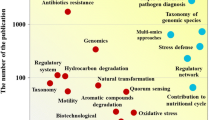Abstract
A new compound, 7,10-dihydroxy-8(E)-octadecenoic acid (DOD), produced from oleic acid by a new bacterial isolate PR3, was discovered in 1991. We have now identified isolate PR3 as a strain of Pseudomonas aeruginosa by DNA reassociation studies. Strain PR3 also produced a crystalline yellowish compound the structure of which, as determined by GC/MS and NMR, is phenazine 1-carboxylic acid (PCA). In cultures of PR3, high PCA production was associated with low DOD accumulation.
Similar content being viewed by others
References
Brisbane, P., Janik, L.J., Tate, M.E. & Warren, P.F.O. 1987 Revised structure for the phenazine antibiotic from Pseudomonas fluorescens 2–79 (NRRL B-15132). Antimicrobial Agents and Chemotherapy 31, 1967–1971.
Chang, P.C. & Blackwood, A.C. 1969 Simultaneous production of three phenazine pigments by Pseudomonas aeruginosa Mac 436. Canadian Journal of Microbiology 15, 439–444.
DeLey, J., Cattoir, H. & Reynaerts, A. 1970 The quantitative measurement of DNA hybridization from renaturation rates. European Journal of Biochemistry 12, 133–142.
Gurusiddaiah, S., Weller, D.M., Sarkar, A. & Cook, R.J. 1986 Characterization of an antibiotic produced by a strain of Pseudomonas fluorescens inhibitory to Gaeumannomyces graminis var. tritici and Pythium spp. Antimicrobial Agents and Chemotherapy 29, 488–495.
Haynes, W.C., Wickerham, L.J. & Hesseltine, C.W. 1955 Maintenance of cultures of industrially important microorganisms. Applied Microbiology 3, 361–368.
Hou, C.T. & Bagby, M.O. 1991 Production of a new compound, 7,10-dihydroxy-8(E)-octadecenoic acid from oleic acid by Pseudomonas sp. PR3. Journal of Industrial Microbiology 7, 123–130.
Hou, C.T. & Bagby, M.O. 1992 10-Hydroxy-8(Z)-octadecenoic acid, an intermediate in the bioconversion of oleic acid to 7,10-dihydroxy-8(E)-octadecenoic acid. Journal of Industrial Microbiology 9, 103–108.
Hou, C.T., Bagby, M.O., Plattner, R.D. & Koritala, S. 1991 A novel compound, 7,10-dihydroxy-8(E)-octadecenoic acid from oleic acid by bioconversion. Journal of the American Oil Chemists Society 68, 99–101.
Kanner, D., Gerber, N.N. & Bartha, R. 1978 Pattern of phenazine pigment production by a strain of Pseudomonas aeruginosa. Journal of Bacteriology 134, 690–692.
King, E.O., Ward, M.K. & Raney, D.E. 1954 Two simple media for the demonstration of pyocyanin and fluorescein. Journal of Laboratory Clinical Medicine 44, 301–307.
Mandel, M. & Marmur, J. 1968 Use of ultraviolet absorbance-temperature profile for determining the guanine plus cystosine content of DNA. Methods in Enzymology 12, 195–206.
Maniatis, T., Fritsch, E.F. & Sambrook, J. 1982 Molecular Cloning, a Laboratory Manual. New York: Cold Spring Harbor Laboratory.
Marmur, J. 1961 A procedure for isolation of deoxyribonucleic acid from microorganisms. Journal of Molecular Biology 3, 208–218.
Palleroni, N. 1984 Family I. Pseudomonadaceae Winslow, Broadhurst, Buchanan, Krumweide, Rogers and Smith 1917. In Bergey's Manual of Systematic Bacteriology, Vol. 1, eds Kreig, N.R. & Holt, J.G. pp. 141–219. Baltimore: Williams and Wilkins.
Romer, A. 1982 Proton NMR spectra of substituted phenazines. Organic Magnetic Resonance 19, 66–68.
Takeda, R. 1958 Pseudomonas pigments. II. Two pigments, 1-phenazine-carboxylic acid and hydroxychloraphine, produced by Pseudomonas aeruginosa T359. Hakko Kogaku Zasshi 36, 286–290.
Toohey, J.I., Nelson, C.D. & Krothov, G. 1965 Isolation and identification of two phenazines from a strain of Pseudomonas aureofaciens. Canadian Journal of Botany 43, 1055–1062.
Author information
Authors and Affiliations
Additional information
The mention of firm names or trade products does not imply that they are endorsed or recommended by the US Department of Agriculture over other firms or similar products not mentioned.
Rights and permissions
About this article
Cite this article
Hou, C.T., Nakamura, L.K., Weisleder, D. et al. Identification of NRRL strain B-18602 (PR3) as Pseudomonas aeruginosa and effect of phenazine 1-carboxylic acid formation on 7,10-dihydroxy-8(E)-octadecenoic acid accumulation. World J Microbiol Biotechnol 9, 570–573 (1993). https://doi.org/10.1007/BF00386296
Received:
Accepted:
Issue Date:
DOI: https://doi.org/10.1007/BF00386296




